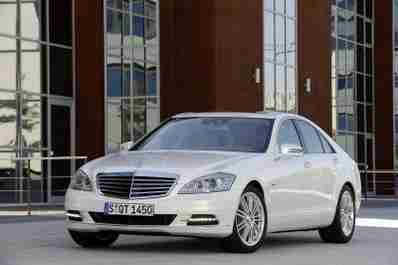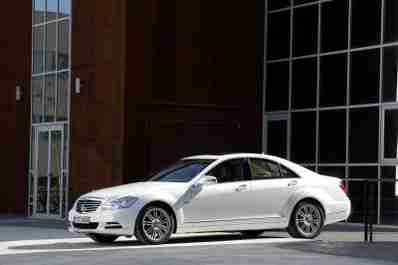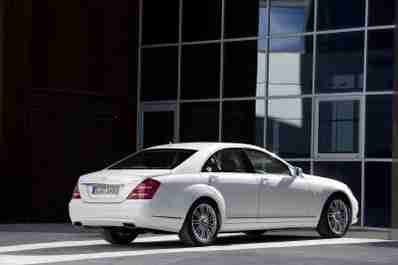|
 Technological highlights include the
world's first series-production hybrid drive system with a lithium-ion battery
in the S 400 HYBRID, which makes this flagship Mercedes-Benz model the world's
most economical luxury saloon with a petrol engine. Its fuel consumption
of 7.9 litres per 100 kilometres corresponds to carbon dioxide emissions
of just 186 grams per kilometre. This makes the new S 400 HYBRID the
"CO2 champion in the luxury class". In addition the engine range
includes eight up-to-date petrol and diesel units, which generate the same,
high output as in the preceding series but require up to seven percent less
fuel. The high safety standard typical of the S-Class is further improved
by a unique combination of new camera and radar based driver assistance systems,
with innovations such as Speed Limit Assist, ATTENTION ASSIST drowsiness
detection and Adaptive Highbeam Assist. More agility and driving enjoyment
is ensured by Direct-Steer and modified Active Body Control with crosswind
stabilisation for the eight and twelve-cylinder models.
The new
luxury saloon will be in the showrooms of Mercedes-Benz's own-retail outlets
and authorised dealerships from June 2009. With 270,000 units sold
since its market launch in autumn 2005, the W 221-series S-Class is the world's
most successful luxury saloon. Since 1951, when the Model 220 founded the
lineage of the S-Class, Mercedes-Benz has sold around 3.3 million units of
this model series. Dr. Dieter Zetsche, Chairman of Daimler AG and CEO of
Mercedes-Benz Cars: "The S-Class is the worldwide market leader. Thanks to
innovative technology, first-class comfort and trailblazing safety systems,
the flagship model from Mercedes-Benz is seen as a pioneer in automotive
development." Technological highlights include the
world's first series-production hybrid drive system with a lithium-ion battery
in the S 400 HYBRID, which makes this flagship Mercedes-Benz model the world's
most economical luxury saloon with a petrol engine. Its fuel consumption
of 7.9 litres per 100 kilometres corresponds to carbon dioxide emissions
of just 186 grams per kilometre. This makes the new S 400 HYBRID the
"CO2 champion in the luxury class". In addition the engine range
includes eight up-to-date petrol and diesel units, which generate the same,
high output as in the preceding series but require up to seven percent less
fuel. The high safety standard typical of the S-Class is further improved
by a unique combination of new camera and radar based driver assistance systems,
with innovations such as Speed Limit Assist, ATTENTION ASSIST drowsiness
detection and Adaptive Highbeam Assist. More agility and driving enjoyment
is ensured by Direct-Steer and modified Active Body Control with crosswind
stabilisation for the eight and twelve-cylinder models.
The new
luxury saloon will be in the showrooms of Mercedes-Benz's own-retail outlets
and authorised dealerships from June 2009. With 270,000 units sold
since its market launch in autumn 2005, the W 221-series S-Class is the world's
most successful luxury saloon. Since 1951, when the Model 220 founded the
lineage of the S-Class, Mercedes-Benz has sold around 3.3 million units of
this model series. Dr. Dieter Zetsche, Chairman of Daimler AG and CEO of
Mercedes-Benz Cars: "The S-Class is the worldwide market leader. Thanks to
innovative technology, first-class comfort and trailblazing safety systems,
the flagship model from Mercedes-Benz is seen as a pioneer in automotive
development."
S 400 HYBRID: the world's most efficient
petrol-engined luxury saloon
 The 2009 S-Class likewise leads the
field in automotive development. Mercedes-Benz is underlining this claim
to leadership with the new S 400 HYBRID, the world's first series-production
vehicle to be equipped with a hybrid drive system using a lithium-ion battery.
This is a pioneering step by Mercedes-Benz on the way to the electrification
of the automobile. The combination of a further developed V6 petrol engine
and a compact hybrid module also makes the S 400 HYBRID the world's most
efficient luxury saloon with a petrol engine. The combined New European Driving
Cycle (NEDC) fuel consumption is only 7.9-8.1 litres per 100 kilometres.
This results in the world's lowest CO2 emissions in this vehicle
class, at just 186 - 189 grams per kilometer. These figures are accompanied
by a truly superior performance potential: the modified 3.5-litre petrol
engine develops 205 kW/279 hp, while the electric motor generates 15 kW/20
hp and a starting torque of 160 Nm. The combined output is therefore 220
kW/299 hp, with a combined maximum torque of 385 newton metres. The Mercedes-Benz
S 400 HYBRID is based on the S 350, and features an extensively modified
drive train. This encompasses a further development of the 3.5-litre V6 petrol
engine, an additional magneto-electric motor, the 7G-TRONIC seven-speed automatic
transmission specially configured for the hybrid module, the necessary operating
and control electronics, the transformer and a high-voltage lithium-ion battery.
The hybrid module also has a convenient ECO start/stop function, which
automatically switches the engine off when the vehicle stops - for example
at traffic lights. The 2009 S-Class likewise leads the
field in automotive development. Mercedes-Benz is underlining this claim
to leadership with the new S 400 HYBRID, the world's first series-production
vehicle to be equipped with a hybrid drive system using a lithium-ion battery.
This is a pioneering step by Mercedes-Benz on the way to the electrification
of the automobile. The combination of a further developed V6 petrol engine
and a compact hybrid module also makes the S 400 HYBRID the world's most
efficient luxury saloon with a petrol engine. The combined New European Driving
Cycle (NEDC) fuel consumption is only 7.9-8.1 litres per 100 kilometres.
This results in the world's lowest CO2 emissions in this vehicle
class, at just 186 - 189 grams per kilometer. These figures are accompanied
by a truly superior performance potential: the modified 3.5-litre petrol
engine develops 205 kW/279 hp, while the electric motor generates 15 kW/20
hp and a starting torque of 160 Nm. The combined output is therefore 220
kW/299 hp, with a combined maximum torque of 385 newton metres. The Mercedes-Benz
S 400 HYBRID is based on the S 350, and features an extensively modified
drive train. This encompasses a further development of the 3.5-litre V6 petrol
engine, an additional magneto-electric motor, the 7G-TRONIC seven-speed automatic
transmission specially configured for the hybrid module, the necessary operating
and control electronics, the transformer and a high-voltage lithium-ion battery.
The hybrid module also has a convenient ECO start/stop function, which
automatically switches the engine off when the vehicle stops - for example
at traffic lights.
The lithium-ion battery stores recovered kinetic
energy
When the vehicle is braked the electric motor acts as a generator, and is
able to recover braking energy by a process of recuperation. Working in finely
tuned partnership, the electric motor supplements the braking effect of the
combustion engine and the wheel brakes to deliver a smoothly progressive
braking action. The recuperated energy is stored in a compact yet highly
efficient lithium-ion battery in the engine compartment, and made available
when required. This complex system is managed by a high-performance control
unit, which is likewise located in the engine compartment. Major advantages
over conventional nickel/metal hydride batteries include a higher energy
density and greater electrical efficiency combined with more compact dimensions
and a low battery weight. Thanks to space-saving installation in the engine
compartment, the boot capacity and generous interior dimensions remain unchanged.
Efficient diesel and petrol engines
 In addition to the trailblazing hybrid
drive unit of the S 400 HYBRID, the 2009 S-Class is available with a choice
of eight engines: two diesel units and six petrol units with six, eight and
twelve cylinders. By means of specific aerodynamic fine-tuning, tyres with
a lower rolling resistance and modifications to the steering, fuel pump and
7G-TRONIC automatic transmission, Mercedes-Benz developers have been able
to reduce both fuel consumption and CO2 emissions by up to seven percent.
With diesel fuel consumption of up to 7.6 litres per 100 kilometres and CO2
emissions of 199-201 grams per kilometre, the S 350 CDI BlueEFFICIENCY (173
kW/235 hp) likewise boasts outstanding figures for the luxury class.
Mercedes-Benz achieves this exemplary efficiency with a tailor-made
BlueEFFICIENCY package, which also includes closed underbody panelling and
decoupling of the 7G-TRONIC automatic transmission at standstill. The 3.0-litre
diesel engine is also used in the S 350 CDI 4MATIC. The second diesel variant
is the eight-cylinder S 450 CDI (235 kW/320 hp) with a displace-ment of 4.0
litres. The range of petrol engines comprises the six-cylinder S 350/ S 350
4MATIC (200 kW/272 hp) with a displacement of 3.5 litres and the two
eight-cylinder units in the S 450/S 450 4MATIC (250 kW/340 hp; displacement
4.7 litres) and S 500/S 500 4MATIC (285 kW/388 hp; displacement 5.5 litres).
The flagship model is still the S 600 with the 380 kW/517 hp twelve-cylinder
biturbo unit), which accelerates the luxury saloon to 100 km/h in 4.6 seconds.
The Mercedes-AMG high-performance contributions to the range are the S 63
AMG with its 386 kW/525 hp V8 engine (displacement 6.2 litres) and the S
65 AMG with a 459 kW/612 hp twelve-cylinder engine (displacement 6 litres).
The Mercedes-AMG high-performance contributions to the range are the S 63
AMG with its 386 kW/525 hp V8 engine (displacement 6.2 litres) and the S
65 AMG with a 450 kW/612 hp twelve-cylinder engine (displacement 6 litres). In addition to the trailblazing hybrid
drive unit of the S 400 HYBRID, the 2009 S-Class is available with a choice
of eight engines: two diesel units and six petrol units with six, eight and
twelve cylinders. By means of specific aerodynamic fine-tuning, tyres with
a lower rolling resistance and modifications to the steering, fuel pump and
7G-TRONIC automatic transmission, Mercedes-Benz developers have been able
to reduce both fuel consumption and CO2 emissions by up to seven percent.
With diesel fuel consumption of up to 7.6 litres per 100 kilometres and CO2
emissions of 199-201 grams per kilometre, the S 350 CDI BlueEFFICIENCY (173
kW/235 hp) likewise boasts outstanding figures for the luxury class.
Mercedes-Benz achieves this exemplary efficiency with a tailor-made
BlueEFFICIENCY package, which also includes closed underbody panelling and
decoupling of the 7G-TRONIC automatic transmission at standstill. The 3.0-litre
diesel engine is also used in the S 350 CDI 4MATIC. The second diesel variant
is the eight-cylinder S 450 CDI (235 kW/320 hp) with a displace-ment of 4.0
litres. The range of petrol engines comprises the six-cylinder S 350/ S 350
4MATIC (200 kW/272 hp) with a displacement of 3.5 litres and the two
eight-cylinder units in the S 450/S 450 4MATIC (250 kW/340 hp; displacement
4.7 litres) and S 500/S 500 4MATIC (285 kW/388 hp; displacement 5.5 litres).
The flagship model is still the S 600 with the 380 kW/517 hp twelve-cylinder
biturbo unit), which accelerates the luxury saloon to 100 km/h in 4.6 seconds.
The Mercedes-AMG high-performance contributions to the range are the S 63
AMG with its 386 kW/525 hp V8 engine (displacement 6.2 litres) and the S
65 AMG with a 459 kW/612 hp twelve-cylinder engine (displacement 6 litres).
The Mercedes-AMG high-performance contributions to the range are the S 63
AMG with its 386 kW/525 hp V8 engine (displacement 6.2 litres) and the S
65 AMG with a 450 kW/612 hp twelve-cylinder engine (displacement 6 litres).
Unique combination of driver assistance
systems
A combination of ultra-modern assistance and protection systems turns the
S-Class into an "intelligent" partner that can see, feel, respond reflexively
and act independently to prevent accidents or mitigate their effects. For
the first time Mercedes-Benz also uses cameras in these systems - these are
able to look well ahead, monitor the car's surroundings and interpret critical
situations. One example is the optional Adaptive Highbeam Assist. This system
recognises oncoming vehicles or vehicles ahead with their lights on, and
then controls the headlamps to ensure the best possible beam range without
dazzling other road users. As a new feature the Night View Assist Plus with
infrared camera is now equipped with a special pedestrian detection function:
as soon as the system detects pedestrians on the road ahead, they are highlighted
on the display to make them more readily noticeable. Lane Keeping Assist
is another system that "looks ahead" for even safer driving. The camera on
the inside of the windscreen is able to recognise clear lane markings by
evaluating the contrasting images of the road surface and the markings. If
the vehicle leaves its lane unintentionally, the driver is warned by short
vibrations of the steering wheel. Unlike conventional systems of this kind,
the Mercedes system is able to evaluate the driver's activities as well,
and can reliably ascertain whether the car is leaving its lane intentionally
or not. There is therefore no warning if the driver e.g. accelerates before
overtaking or joining a motorway, brakes heavily or enters a bend. The images
supplied by the windscreen camera are also used by the new, optional Speed
Limit Assist, which recognises speed limit signs in passing and shows the
relevant speed limit in the central display (standard for S 600).
Drowsiness detection on the basis of more than
70 parameters
Thanks to an innovative technology the 2009 S-Class has a very sensitive
antenna for the attention level of its driver, and can warn him in time when
he becomes drowsy. The drowsiness detection system ATTENTION ASSIST continuously
monitors more than 70 different parameters. Once the evaluation electronics
recognise the steering behaviour pattern that typically indicates the onset
of drowsiness on the basis of information from the highly sensitive steering
angle sensor, a warning signal is sounded and "ATTENTION ASSIST. Break!"
appears in the instrument cluster. Attention Assist is standard equipment*
in the 2009 S-Class.
* not for S 400 HYBRID
"Electronic crumple zone" for maximum occupant
protection
Mercedes-Benz has also improved the long and medium-range radar used by Brake
Assist (BAS) PLUS and DISTRONIC PLUS proximity cruise control. Mercedes-Benz
also offers another radar based system for the S-Class in the form of the
PRE-SAFE® brake. If the driver is distracted and fails to recognise the
immediate danger of a rear-end collision, or the warning signal of an assistance
system, this system can intervene and brake the vehicle independently. The
2009 S-Class makes use of the latest development stage of this safety system:
if the driver fails to react even after automatic, partial braking action,
the PRE-SAFE® Brake activates the maximum braking pressure around 0.6
seconds before what is now recognised as an unavoidable accident -- an emergency
braking action that can significantly mitigate the severity of the impact.
The PRE-SAFE® Brake therefore acts as something like an "electronic crumple
zone".
New: Active Body Control reduces the effect
of a crosswind
The S-Class also meets the highest expectations with respect to driving dynamics
and agility. This is in part due to Direct-Steer, with a steering ratio that
varies with the steering angle, and modified Active Body Control (ABC) with
crosswind stabilisation (optional for the eight-cylinder models with rear-wheel
drive, standard for S 600). For this purpose ABC uses the yaw rates and lateral
acceleration sensors of the Electronic Stability Program ESP® to vary
the wheel load distribution via the ABC spring struts within milliseconds,
depending on the direction and intensity of the crosswind. This enables the
effects of crosswinds to be largely compensated. Extra safety at the physical
limits, as well as even more agility, is provided by the Torque Vectoring
Brake in the 2009 S-Class - targeted, one-sided braking intervention at the
inside rear wheel when cornering. The result is a defined turning moment
around the vehicle's vertical axis, which means that the car turns into the
bend precisely and without any loss of handling dynamics. This Torque Vectoring
Brake function is standard equipment in the 2009 S-Class. Powerful and
self-assured presence The modified design of the 2009 S-Class reflects the
effortless superiority and power of the S-Class Saloon. It is characterised
by the more pronounced arrow-shape of the radiator grille, plus a new front
bumper with a discreet light-catching contour and a chrome strip below the
cooling air intakes. The headlamps have bi-xenon technology as standard.
An even more dynamic look is ensured by the LED Light package with its striking
LED arrays for daytime driving lights, indicators and driving lights (standard
for S 400 HYBRID and S 600). They lend an unmistakable day-and-night design
to the front end. The rear end is characterised by tail lights in a new design,
with horizontal, white light rather than the previous inserts in the vehicle
colour. Here too, a total of 52 LEDs arranged in a curved design form an
unmistakable light signature. Mercedes-Benz also makes more use of light
as a styling element in the interior. In future customers who specify the
optional ambient lighting (standard for S 400 HYBRID and S 600) have a choice
between three lighting moods: solar (amber), neutral (white) and polar
(ice-blue).
State-of-the-art multimedia technology
In line with its serene character and claim to be a technological trendsetter,
the 2009 S-Class also sets standards where onboard infotainment is concerned.
As a world first, and on request, Mercedes-Benz will equip its flagship model
with the new SPLITVIEW technology for the COMAND control and display system
centrally located in the centre console. This innovative display concept
allows the driver and front passenger to view different content simultaneously
on one and the same screen. While the driver e.g. uses the map-based navigation
system, the front passenger can be watching the latest film on DVD. Mercedes-Benz
has also extended the standard control and display system COMAND with additional
functions, for example an SD memory card slot. Other new features include
a Bluetooth® interface, which wirelessly connects a mobile phone to the
standard onboard hands-free system, and a USB interface. These enable customers
to export saved data and import them into any other S-Class. It is also possible
to transfer navigation data to another vehicle. As an optional extra
Mercedes-Benz also offers a media interface - a universal interface in the
glove compartment for mobile audio devices like an iPod® and USB stick
also with AUX input (standard for S 400 HYBRID and S 600). The optionally
available COMAND APS (standard for S 400 HYBRID and S 600) is additionally
equipped with a Europe-wide navigation system whose data are stored on a
40 GB hard disc. This allows particularly fast route calculation. The high
level of navigating convenience is also aided by the detailed three-dimensional
map display. Musical entertainment is provided by a radio, a CD/DVD player
with MP3 function, an equalizer with speed-dependent volume control and the
MUSIC REGISTER with a 7.2 GB hard disc which stores around 2500 digital music
files in the MP3, AAC or WMA format. The system recognises music files played
on CD, DVD or from the MUSIC REGISTER using its stored Gracenote® database,
and shows the title, album and performer in the colour display. The new Music
Search function enables S-Class drivers and passengers to search SD memory
cards, USB sticks, CDs and DVDs for specific music titles and performers.
COMAND APS also includes the latest-generation LINGUATRONIC voice-operated
control system, which operates the navigation, telephone and audio devices
by whole-word commands. This has the advantage that the driver no longer
has to spell out his commands. To enter a destination, select a radio station,
choose a title from the MUSIC REGISTER or access a contact in the phone
directory, he only needs to say what he wants. Mercedes-Benz has also increased
the range of rear seat entertainment functions in the 2009 S-Class. As standard
equipment, passengers in the rear now have a remote control unit which enables
all the audio and telematics functions of COMAND to be operated, plus access
to external devices via the Media Interface. Mercedes-Benz also offers a
Rear Seat Entertainment package with two eight-inch displays on the rear
surfaces of the front seat head restraints, two wireless headphones and a
separate CD/DVD player with connections for external audio and video devices.
The surround sound system with "Logic 7" technology developed by Mercedes-Benz
together with the audio specialists Harman Kardon® delivers an outstanding
performance with three-dimensional sound as a natural 360-degree musical
experience for all passengers.
Interior: carefully selected materials and
first-class finishing
The multifunction steering wheel of the S-Class has also been modified by
the Mercedes-Benz designers: in future the rim and airbag module are lined
wth soft nappa leather as standard. The new, flatter airbag module also lends
a sporty touch to the multifunction steering wheel. When choosing the interior,
S-Class customers now have even more scope for their personal preferences.
A total of five different types of wood trim provide perfectly coordinated
material and colour concepts to suit personal tastes. To make the decision-making
process easier, Mercedes-Benz designers have developed three new interior
combinations for the colour scheme: alpaca grey/basalt grey, cashmere
beige/savanna beige and chestnut brown/black. Together with an all-black
interior for the comfort-oriented business saloon and the well-proven combination
of sahara beige/black, this produces a total of five tasteful interior design
options. In addition to high-grade fabrics, leather upholstery in three qualities
is available as an option. |
